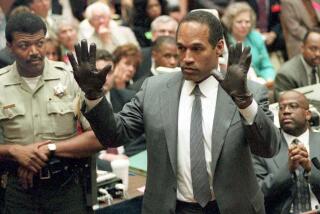Crime News, Without Context, Equals Bias : Local TV news coverage has race problems, but they’re not what you might first think.
Columnists need to avoid the obvious. That’s obvious. But what seems terribly obvious to some Americans may not be to others.
And that, too, is not always so obvious. Here’s a timely example. Two years ago, researchers at UCLA set out to study local TV news coverage, asking whether the apparent emphasis on crime coverage might contribute to racial stereotyping and tension. It seemed a valid topic even then, two years before the O.J verdict and the 800,000-Plus Man March, but after the Rodney King trial ordeal and the L.A. riots. But also an obvious one. Maybe too obvious.
What if, after years of hard work, the study wound up concluding that local TV news aired too much violence and too much crime and that blacks were stereotypically portrayed as violent criminals?
That would be pretty obvious, wouldn’t it? Or would it?
The UCLA researchers had their little lab on campus all dolled up like the average living room and paid a random and diverse sample of university administrative and clerical workers (excluding students) the sum of $10 to watch a 15-minute videotaped news report (including commercials). The lab show was culled from actual news shows, but by design the newscast would contain only one report on crime.
That report always had one three-second close-up of the crime suspect: the mug shot would be doctored by a computer to portray the bad guy as a white man for the first randomly selected group and as an African American man for the second.
Then every viewer filled out a questionnaire about who and what causes crime, the anti-crime remedies they supported and any stereotypes they had of various social groups, including African Americans. The obvious result: People who saw the “black man” version of the newscast were quicker than the other group to blame blacks for crime.
Worse yet, viewers who came to the newscast with what the researchers found was a “high stereotype” attitude about black people came out of the session much more likely “to cite breakdown of the family and religious values in the black community as causes of crime,” according to the preliminary, unpublished draft of the report by UCLA’s Center for American Politics and Public Policy.
Then, moving from the lab to the tube, the researchers picked a local TV news station pretty much at random (it was KABC) and tracked crime coverage during its half-hour 6 p.m. “Action News” program from March, 1993, through March, 1994. As it turns out, the researchers were hard put to fault KABC. In fact, political science professor Shanto Iyengar, a co-leader of the study, says it is his impression that the station probably was considerably better than many that the researchers could have picked. KABC’s depiction of blacks as perpetrators of violent crime was not significantly greater than actual black crime and its depiction of Latinos as perpetrators of violent crime was considerably below the actual Latino violent crime rate.
The issue, as these researchers see it, is not any one local station specifically. It is local TV news generally: They concluded that the medium over-emphasizes violent crime and thus reinforces racial imagery, albeit unwittingly. Of the 148 local TV news broadcasts sampled, 436 stories dealt with crime. Crime was the focus of the lead story 51% of the time and 27% of the violent crime coverage concerned murders. But during that very period, murder accounted for only 2% of felonies in Los Angeles, so the frequency of murder was exaggerated by 14 to 1. As the report’s authors point out, population-adjusted crime rates--both violent and not--have declined over the past two decades. Indeed, even in crime-troubled Los Angeles, reported crime fell 9.3% overall in the first six months of the year; rapes dropped 18%, robberies dropped 17%, homicides 7.8%. In Orange County, reported crime fell 12.7%. But you wouldn’t suspect that from watching TV news. And because the black crime rate is disproportionate to population, the unintended but inevitable consequence for the area’s black community is that when blacks are on TV news, they are often portrayed as violent criminals.
As Iyengar puts it: “We’re not claiming great media racial bias. It’s a more subtle and ominous process. Look at our experimental lab results. They underscore the importance of news coverage to public opinion. A mere three-second exposure to a picture of a black perpetrator in a local newscast proved sufficient to boost the level of concern for crime and affect attributions of causal responsibility.” Adds study co-leader Franklin Gilliam Jr., a UCLA political scientist: “This repeated viewing--violent crime, blacks--has a cumulative effect. Why not give these TV crime stories context? Do viewers realize violent crime has gone down? “
So, maybe the problem is not so obvious.
Or, if it is, maybe sometimes you can’t emphasize the obvious enough.
* Tom Plate’s column runs Tuesdays.
More to Read
The complete guide to home viewing
Get Screen Gab for everything about the TV shows and streaming movies everyone’s talking about.
You may occasionally receive promotional content from the Los Angeles Times.






